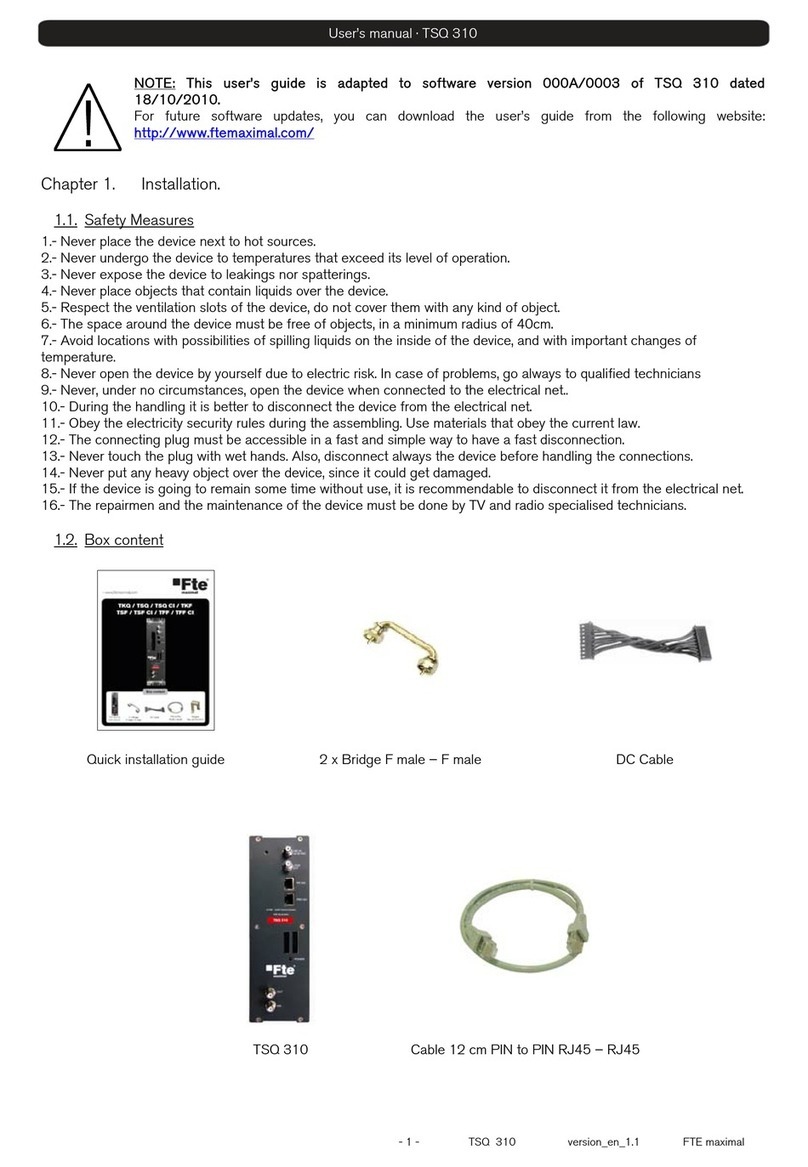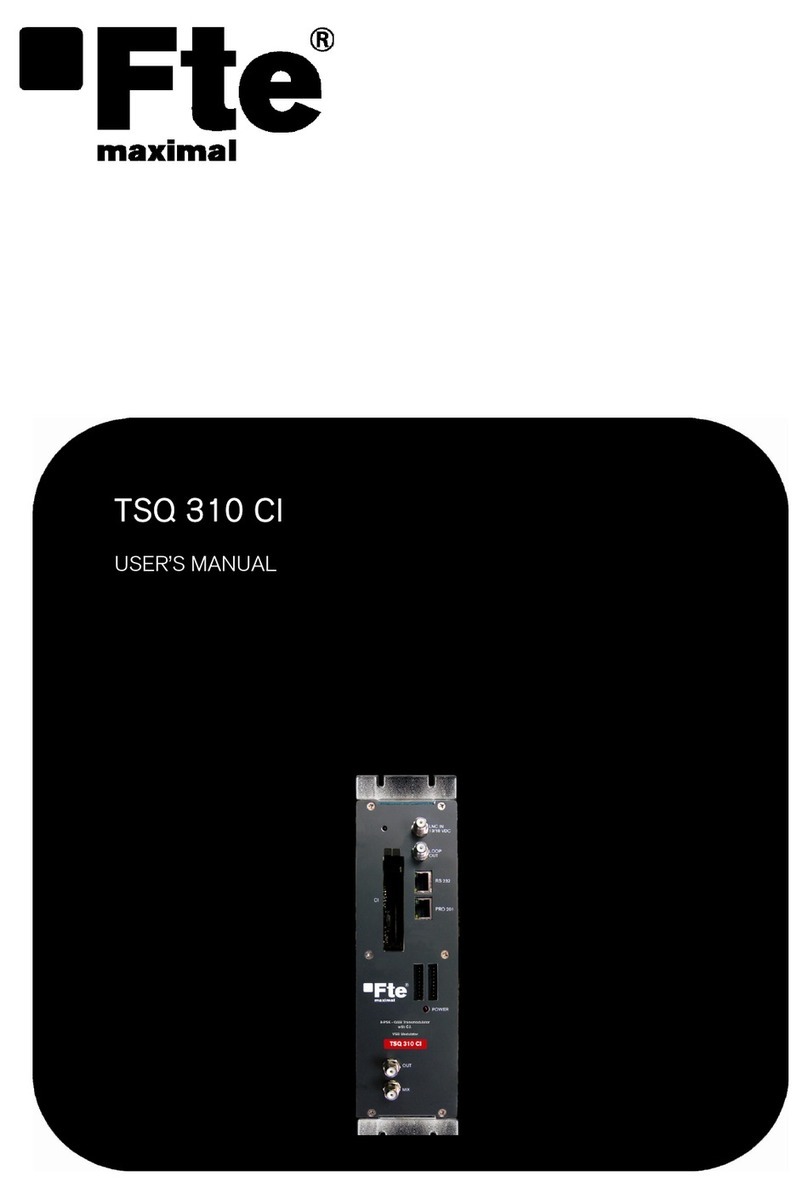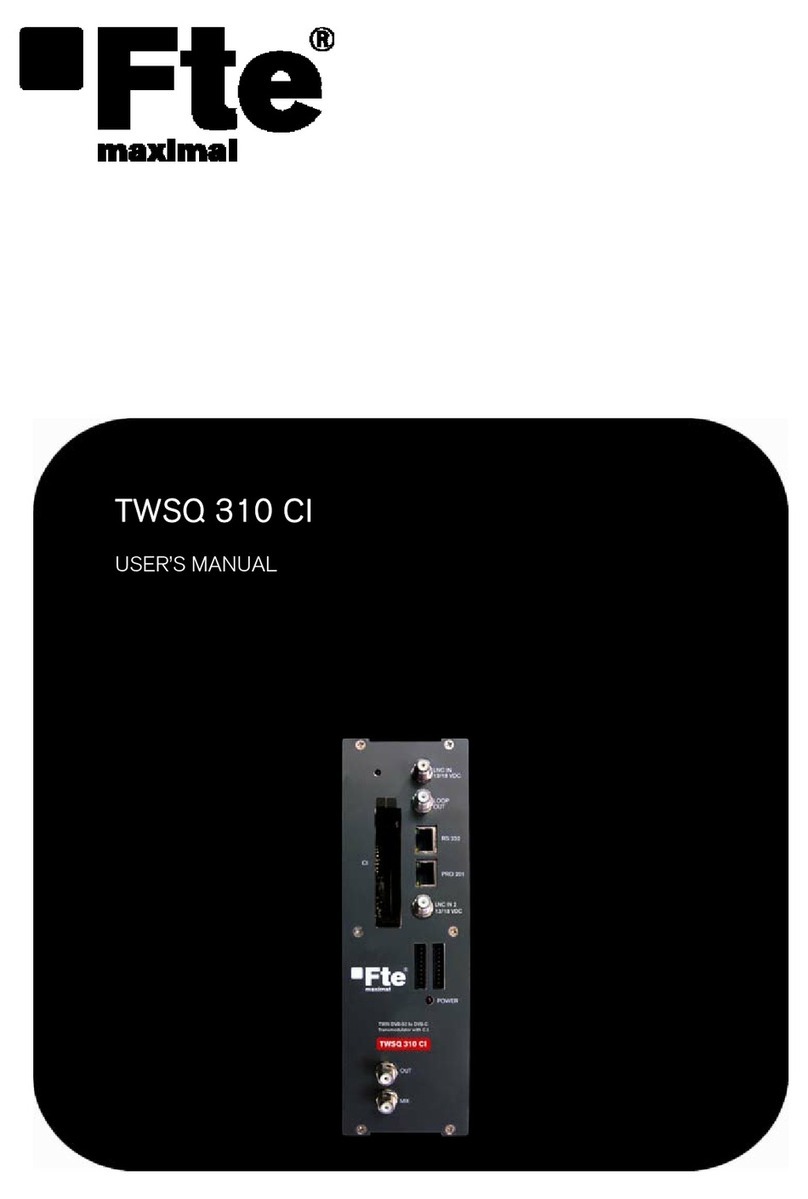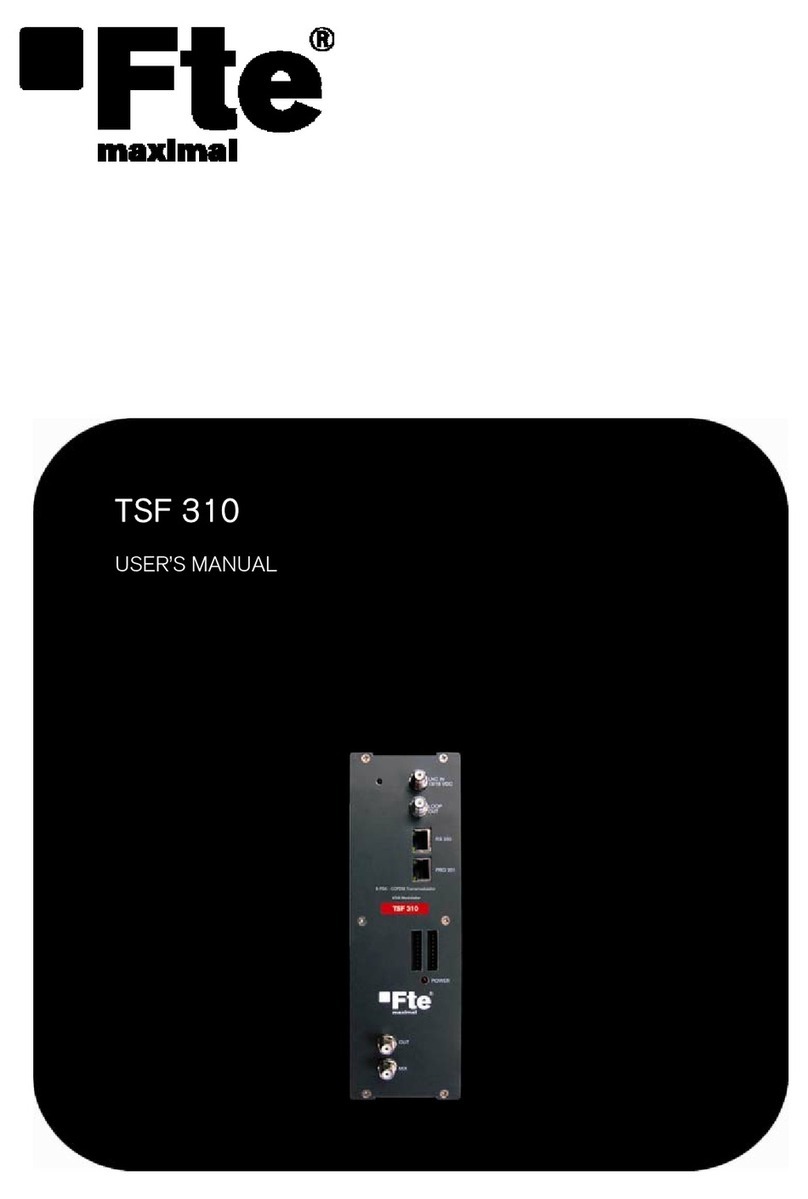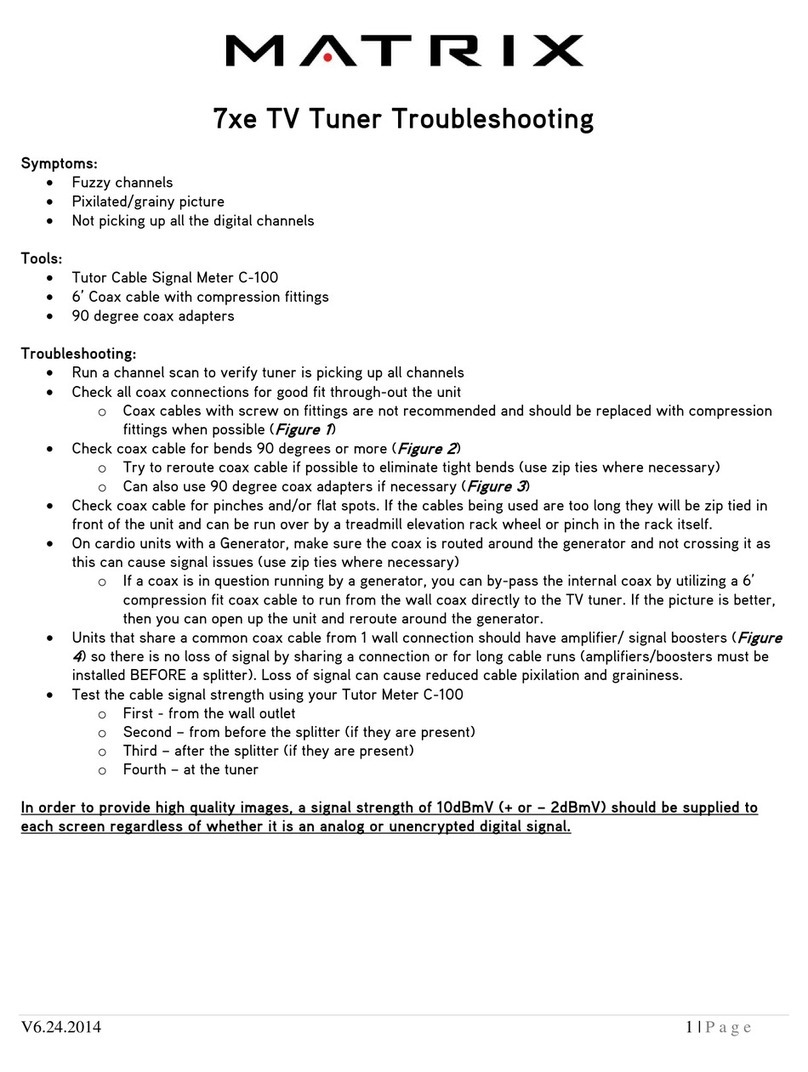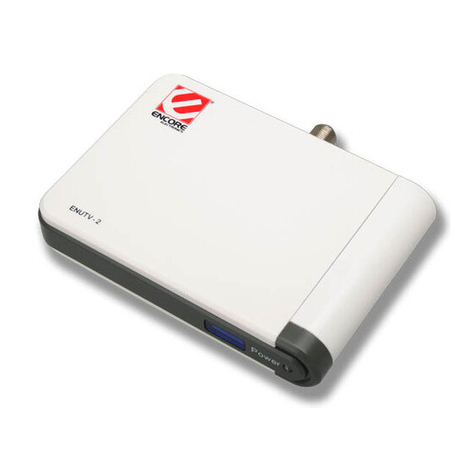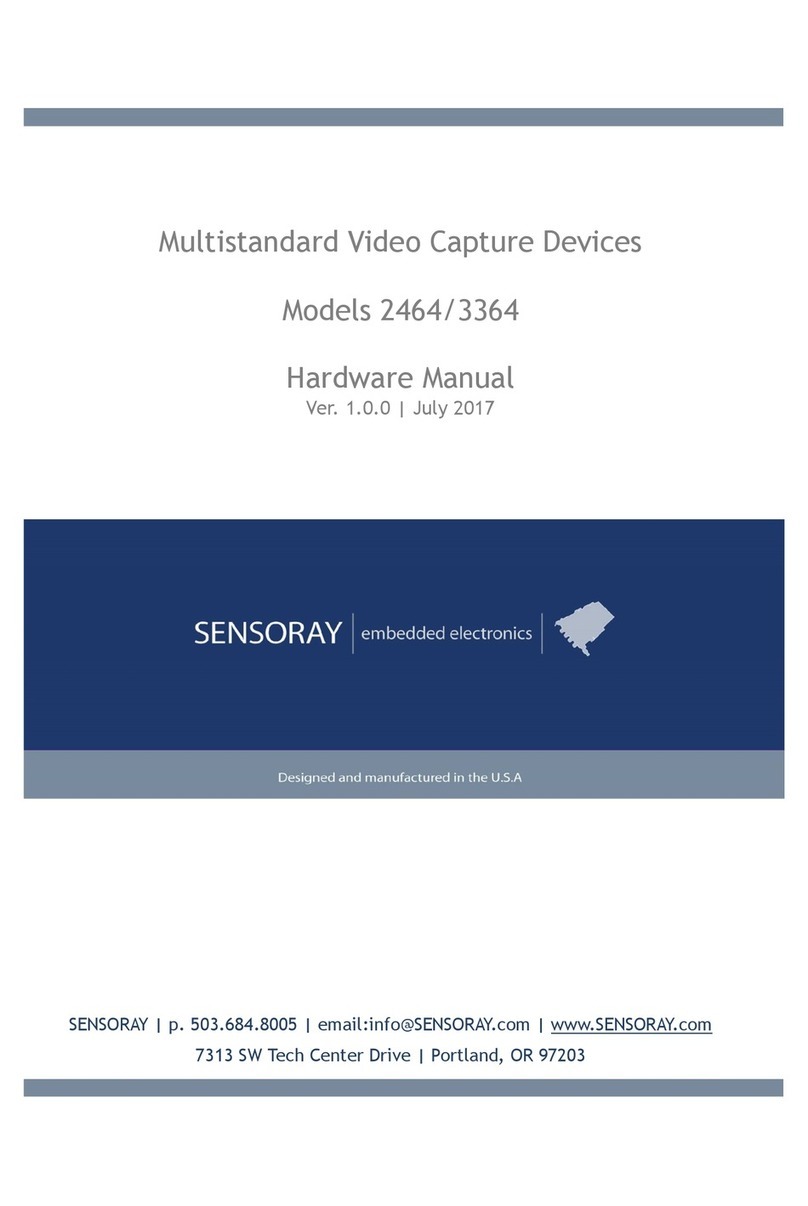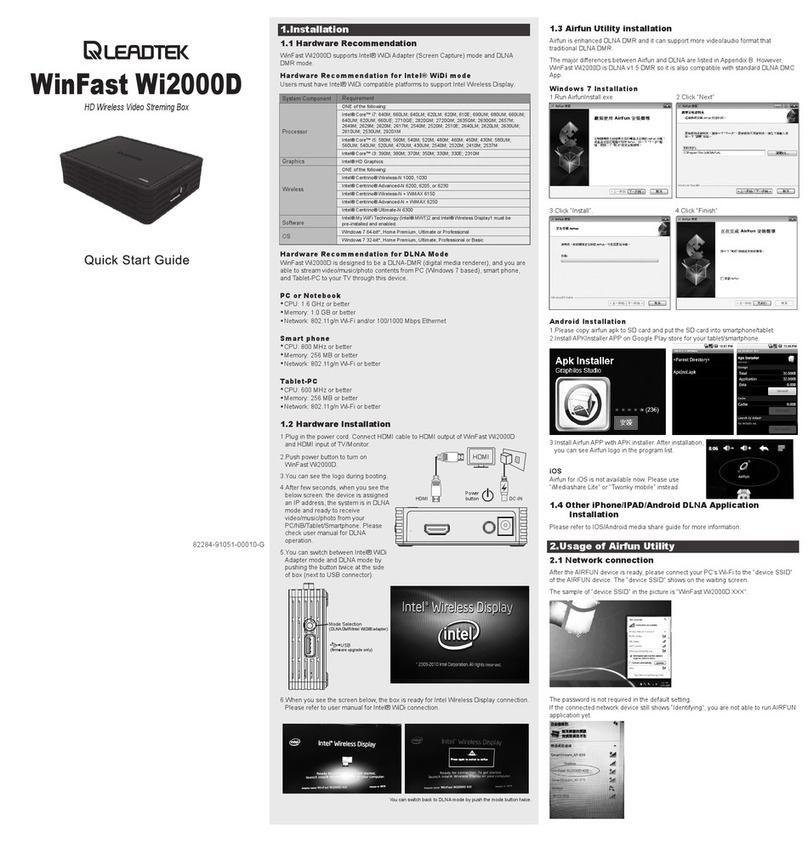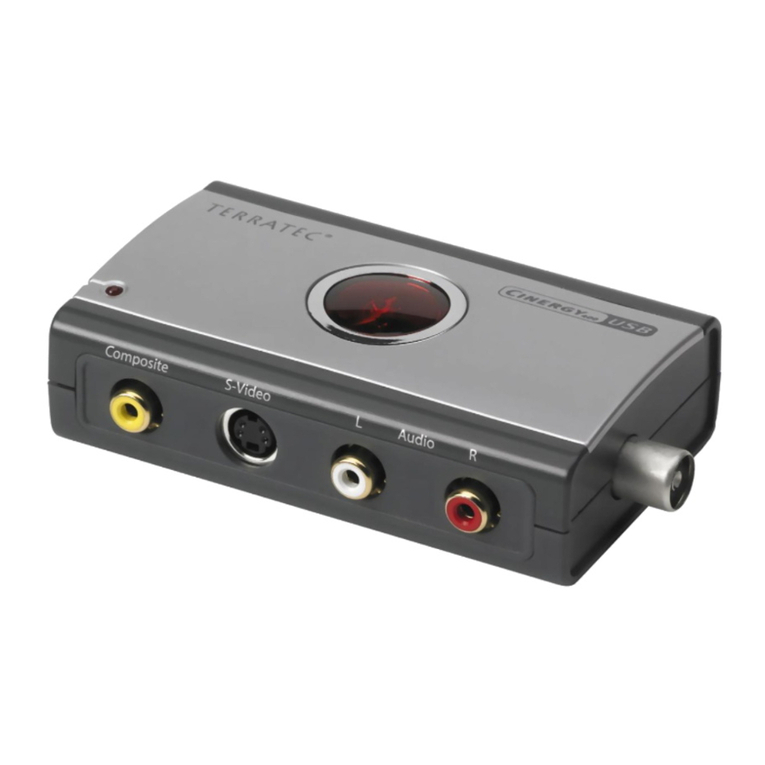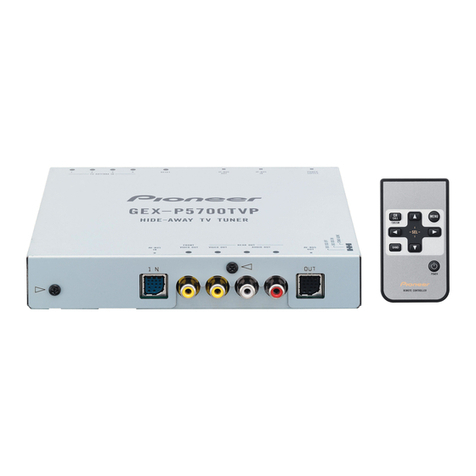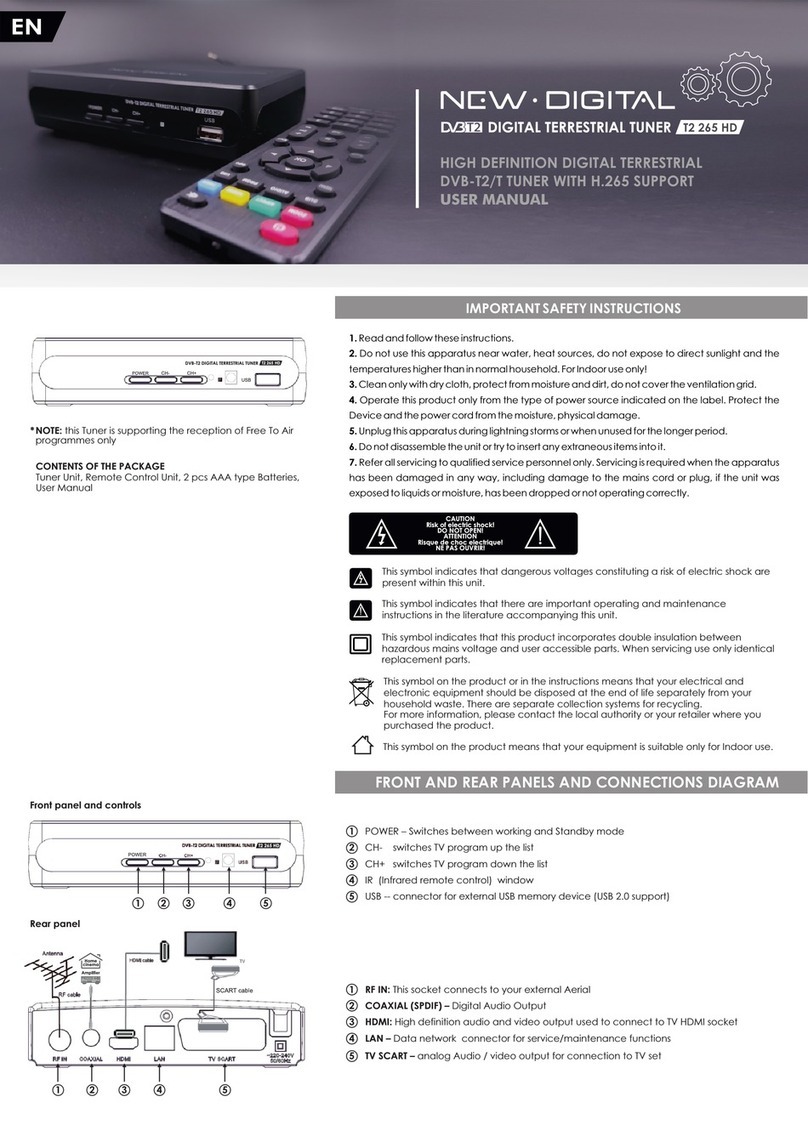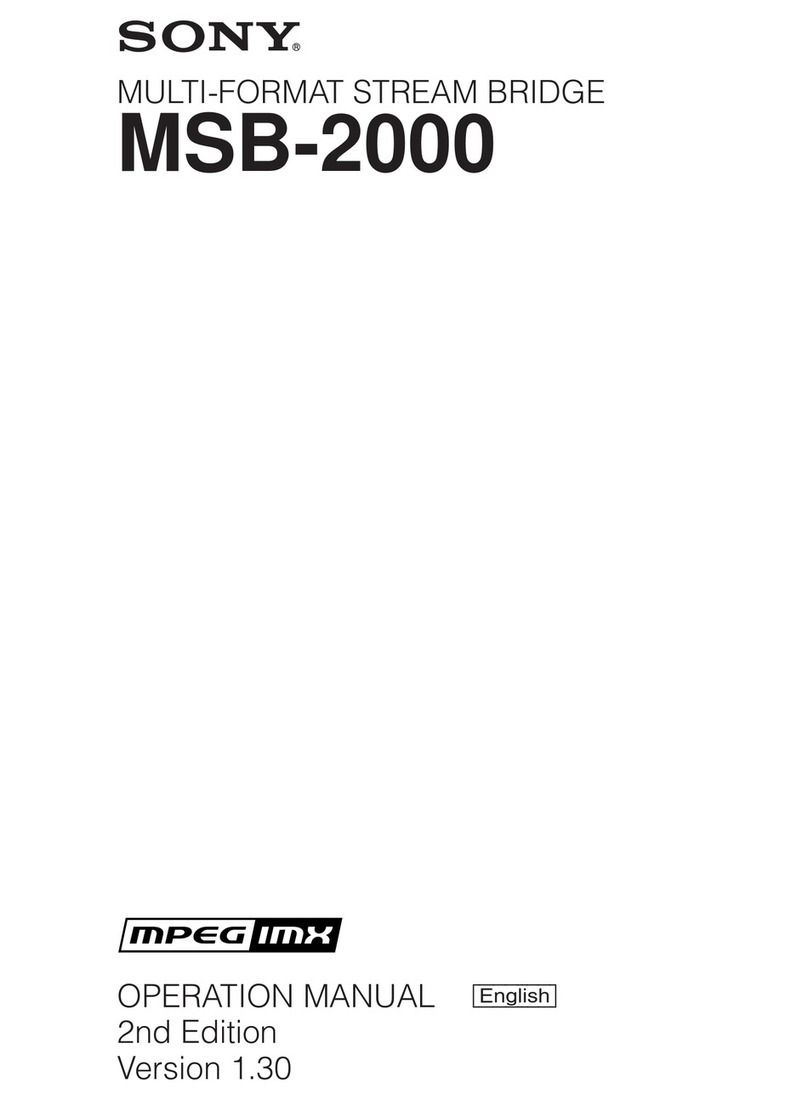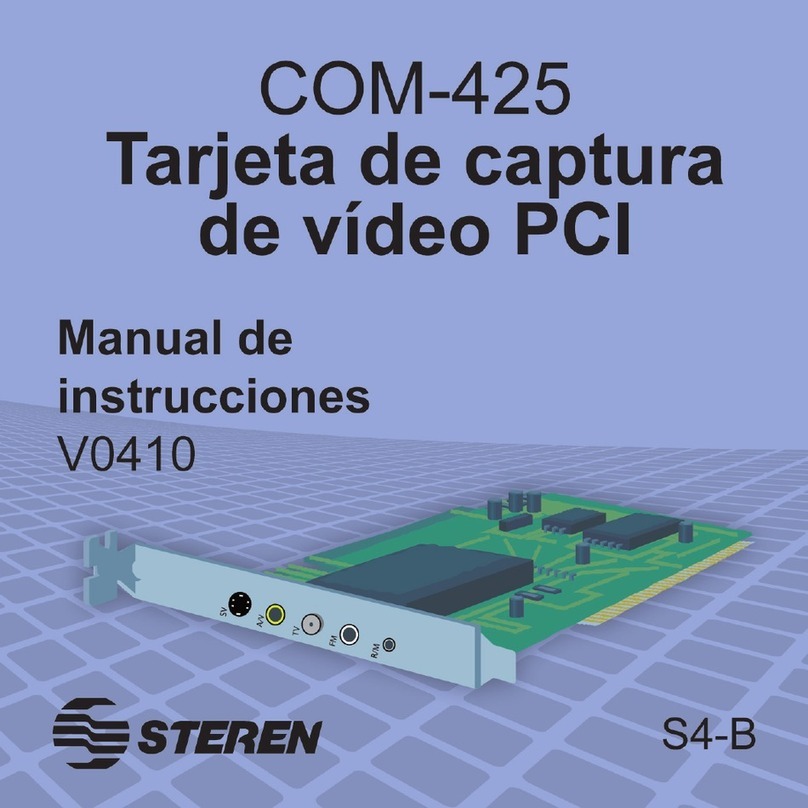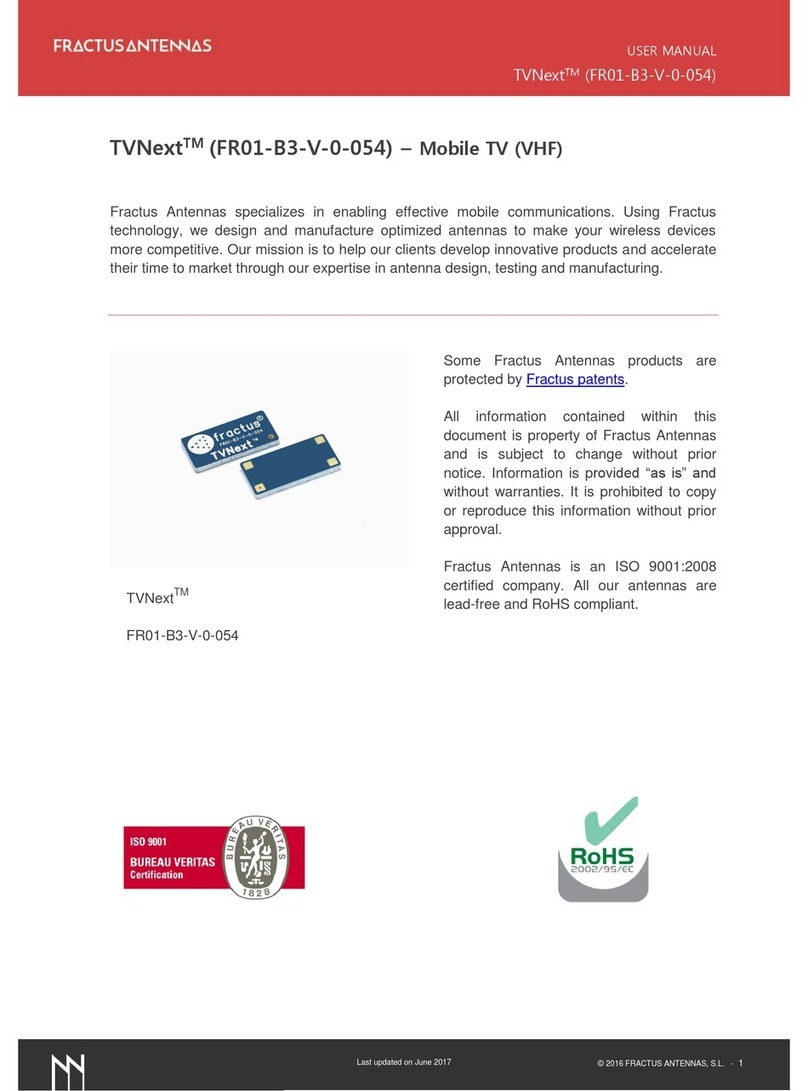FTE Maximal TFF 310 CI User manual

TFF 310 CI
USER’S MANUAL

User’s manual · TFF 310 CI
- 1 - TFF 310 CI version_en_2.0 FTE maximal
NOTE: This user’s guide is adapted to software version v.1.47of TFF 310 CI dated 09/04/2014.
For future software updates, you can download the user’s guide from the following website:
http://www.ftemaximal.com/
Chapter 1. Installation.
1.1. Safety Measures
1.- Never place the device next to hot sources.
2.- Never undergo the device to temperatures that exceed its level of operation.
3.- Never expose the device to leaking nor spattering.
4.- Never place objects that contain liquids over the device.
5.- Respect the ventilation slots of the device, do not cover them with any kind of object.
6.- The space around the device must be free of objects, in a minimum radius of 40cm.
7.- Avoid locations with possibilities of spilling liquids on the inside of the device, and with important changes of
temperature.
8.- Never open the device by yourself due to electric risk. In case of problems, go always to qualified technicians
9.- Never, under no circumstances, open the device when connected to the electrical net..
10.- During the handling it is better to disconnect the device from the electrical net.
11.- Obey the electricity security rules during the assembling. Use materials that obey the current law.
12.- The connecting plug must be accessible in a fast and simple way to have a fast disconnection.
13.- Never touch the plug with wet hands. Also, disconnect always the device before handling the connections.
14.- Never put any heavy object over the device, since it could get damaged.
15.- If the device is going to remain some time without use, it is recommendable to disconnect it from the electrical net.
16.- The repairmen and the maintenance of the device must be done by TV and radio specialised technicians.
1.2. Box content
Quick installation guide 2 x Bridge F male – F male DC Cable
TFF 310 Cable 12 cm PIN to PIN RJ45 – RJ45 Stopper

User’s manual · TFF 310 CI
- 2 - TFF 310 CI version_en_2.0 FTE maximal
1.3. Description and connections
The module TFF 310 CI is used for the reception of free channels that obey the DVB-T standards.
Each module allows the reception of a complete multiplex in DVB-T (COFDM), and its subsequent regeneration in a new
multiplex. Besides, it offers the possibility of selecting the services that you wish to add in the new multiplex.
A feature of this equipment is its modulator in Vestigial Side Band (or VSB). This modulation can be used to distribute
adjacent channels in one distribution without any interference problem.
Each module has one Loop connector to cascade several modules at input and a Mix connector to do same in output
channels. The output channel is selectable between C2 and C69.
All parameters are programmed by the means of PRO 201, PRO 300 or the EVO or MINI series of field strength meter,
and they are monitored in the display of programmer or on the screen of field strength meter.
TFF 310 CI has two Common Interface slots.
TFF 310 CI
*States of two-colored leds
1. Initialization mode
- Green: main application charged.
- Blinking Green: Completing the initial sequence, at the moment when the module gets initialized, the led will turn
into one of the states the operating mode.
- Red: Phase of initializing the module.
2. Operative Mode
- Green: The system is working properly.
- Orange: At least one critical event has been recorded in the module. The led will only change into green when
the registration of events has been read by the programmer.
- Red: Error or alert detected in the running of the device, the led will be on only as long as the error/alert is
present. Once the error or the alert disappears, the led will change into orange because the error/alert is stored in
the registration of events.
3. Programming mode
- When the module detects an external programmer, the led will blink in the next sequence: green-orange-red.
- Once you leave the programming mode, the led will turn into the corresponding operating mode.
6
3
4
5
7
8
9
1
2
1. Two-colored led*: It indicates the different states of the device.
2. CI: Common Interface.
3. OUT: This connector supplies the modulated channel according to the
selected standard in the module and mixes it with all the signals that it
receives throught the MIX connector
4. MIX: Input of mixing of the module.
5. ANT IN: To connect to the antenna or to the LOOP OUT output of the
previous module
6. LOOP OUT: To connect to the ANT IN input of the next module.
7. RS 232: Ethernet connector to cascade modules with the RCM 310
telecontrol unit with the RJ45/RJ45 cable provided.
8. PRO 201: Ethernet connector to make the programming with the
programmer.
9. DC connectors: It has two connectors for connecting between modules.

User’s manual · TFF 310 CI
- 3 - TFF 310 CI version_en_2.0 FTE maximal
Stages of TFF 310 CI regenerator
Input
Reception of a terrestrial multiplex with a typical error rate in the output of the antenna.
Case 1: Regeneration
Case 2: Filtering + Regeneration
Signal regeneration and possibility of making a services filtering.
If the multiplex has encoded channels, in order to distribute them freely you have to install the PCMCIA + subscriber card
in the Common Interface slot.
Out
Configuration of the channel and output parameters of a multiplex with a corrected error rate.
1.4. Programming
TFF 310 CI has two ethernet connectors. In order to make the programming of the module you have to connect the
corresponding programmer to PRO 201 connector.
You can make the programming through the PRO 201, PRO 300 programmers and also through the mediaMAX EVO and
mediaMAX MINI field strength meter.
1.4.1. Programming modes
With mediaMAX EVO / mediaMAX MINI field strength
meter you can carry out the programming of all the
modules consecutively as long as they are interconnected
with each other through the RJ-45 cable supplied with
each unit.
Through PRO 201or PRO 300, the programming is made
module by module.

User’s manual · TFF 310 CI
- 4 - TFF 310 CI version_en_2.0 FTE maximal
1.4.2. Programming
Below you will find the steps to follow in order to make the programming both from corresponding EVO and MINI field
strength meter as well as from PRO 201 and PRO 300.
mediaMAX EVO / mediaMAX MINI
In order to start programming the TFF 310 CI regenerator, you will have to go to “Tools” option through the key 8 of your
field strength meter and to select the “Transmodulator Prog.“ option.
Then, it will proceed to recognize the module and to show the main menu. In the “Transmodulator Prog.” are shown the
different configuration options that this tool offers:
1. Select Device
The field strength meter allows making the programming of one or several regenerator/s and/or transmodulator/s from
only one module.
Without interconnection of modules.
An only module connected
Interconnection of several modules, you can select which
module you wish to program.

User’s manual · TFF 310 CI
- 5 - TFF 310 CI version_en_2.0 FTE maximal
2. Device Status
In the option “Device Status” are specified the main parameters of the module
at this moment.
- Front End: It indicates whether the module is hooked or without
signal.
- Input bit rate: Transfers of data in the terrestrial tuner input.
- Output bit rate: Transfer of data in the module output.
- BER before and after Viterbi: It indicates the error rate of bits of the
input signal before and after the correction produced by Viterbi
algorithm.
- MER: Parameter that indicates the quality of the input modulated
digital signal, expressed in dB.
- Noise Margin: It indicates the difference between the value of current C/N and the value of C/N at the point of
pixilation of the signal, that is, the quantity of dBs of C/N measure that are needed to lose the input signal.
-Temperature: It indicates the current temperature of the module in degrees.
3. Set Front End
In this option you will be able to configure the input parameters of the terrestrial
signal:
- Channel: Input channel of the multiplex that you wish to tune. When
you select the output channel, the field “Frequency (MHz)” will be
modified automatically, adapting itself to the selected channel.
Options: C5-C12/C21-C69.
- Frequency (MHz): Input frequency of the multiplex that you wish to
tune. When you modify this field, the field “Channel” will be also
modified, indicating the channel equivalent to the selected frequency in
the case that this frequency corresponds to the frequency of a channel.
Options: 170-230 / 470-862 MHz.
- Bandwidth: Selection of the input signal Bandwidth: 8MHz, 7MHz and 6MHz.
4. Modulator Set Up
This option allows configuring the DVB-T/DVB-H modulator of the device.
- Bandwidth: Selection of the Bandwidth of the modulated signal:
8MHz, 7MHz, 6MHz and 5MHz. The 5MHz option is only supported by
DVB-H standard.
- FFT Mode: Selection of the number of carriers used in the
modulation. Options: 8K, 4K and 2k. The 4k option is only supported by
DVB-H standard.
-Spectrum inversion: Activate or deactivate the spectrum reverse in the
modulation.
Allows selecting the guard interval of the modulation: 1/4, 1/8, 1/16
and 1/32.
- FEC: Indicates the relationship between the redundant bits and the
transmitted information bits: 1/2, 2/3, 3/4, 5/6 y 7/8. For example, in a FEC = 2/3 relation we will find 2
information bits and 1 redundant bit.
- Modulation: Output modulation format: 4 (4 QAM), 16 (16 QAM), 64 (64 QAM).
- Advanced settings:
- Mode: Selection of the modulation standard: DVB-T and DVB-H.
Note:
The output useful bits rate will depend on the following parameters: Bandwidth, guard interval, FEC
codification and modulation. In the
Attachment I
you will find all the information related to the resulting useful bit
rate in each configuration.

User’s manual · TFF 310 CI
- 6 - TFF 310 CI version_en_2.0 FTE maximal
5. Set Output channel
In this option you can configure the different parameters of the cable signal.
- Channel standard: It allows you to select the channelling of the cable
signal standards. Options: BG, BG, PAL BG IT, LL, M NTSC, PAL M,
PAL N, PAL DK , PAL I, BB_AU, DK PAL, L PAL.
- Channel: Output channel of the cable modulation. When you select the
output channel, the field “Frequency (MHz)” will be modified
automatically, adapting itself to the selected channel. Options: C2-C69.
- Frequency (MHz): Output frequency of cable modulation. When you
modify this field, the field “Channel” will be also modified, indicating the
channel equivalent to the selected frequency in the case that this
frequency corresponds to the frequency of a channel.
Options: 47-862 MHz.
- Level: Regulation of the output level of the modulated signal.
Options: 0-15dB.
- Calibration: Allows the realization of two tests in order to verify the
correct running of the device.
- Deactivate output: It allows activating or deactivating the output of
regenerator.
- Switch output to CW: It allows activating or deactivating the DVB-T /
DVB-H modulation, allowing visualizing the carrier without modulation in
the selected frequency.
6. System
This option provides information of the regenerator.
- System logfile: In this field are indicated the registered events in the
module.
- Read log: It allows reading the registered events in the
module.
- Clear log: It allows deleting all events stored until this
moment.
- Export log to USB: It allows you to export all events
registered to the connected USB device.
- NM low Limit (dB): An event of error will be recorded when
the value of Noise Margin is lower than the set value.
- NM high limit (dB): Once the event of error is recorded (Noise
Margin < Limit Lower NM), this will be Noise Margin value that
will have to be exceed so the module stops being in error.
- Clear log all devices. It allows deleting the events report of all
the interconnected modules.
- Factory default: This option restores the values by default of the
regenerator.
- System information: It allows you to visualize the basic information of
the module: model, no of series, firmware version, etc.
- Settings: This option allows saving and loading the configuration of
the module, carrying out firmware update or making an adjustment of
the time and date of the module.
- Clock:
- Set Date and time: Setting of the date and time of
transmodulator. It is appropriate to maintain these
parameters set in order to have the registration of
errors linked to the current time and date.
- Set date/time all devices: Loading the current date
and time of the module in the rest of interconnected
modules.
-Alias:
- Write alias: It allows you to assign a name/alias to
the module you are programming. Option only available
when the Alias Auto option is configures as “none”
(manual mode).

User’s manual · TFF 310 CI
- 7 - TFF 310 CI version_en_2.0 FTE maximal
- Auto Alias: It allows configuring the name/alias of the modules automatically. Options: Channel,
Frequency, Service, None.
- Upgrade:
- Send Firmware from USB: It allows carrying out the firmware update from the USB device.
- Send firmware to all: It allows carrying out the update of all the modules that are interconnected at the
same time.
- Configure all devices:
- Input values to all devices: It allows copying the current input configuration in all the interconnected
modules.
- Modulator values to all devices: It allows copying the configuration of the current modulator in all the
interconnected modules.
- Output values to all devices: It allows copying the current output configuration in all the interconnected
modules.
- Factory default to all devices: It allows making values by default to all the interconnected modules.
7. Program management
- New program: This option allows creating a program with the current
configuration of a module or group of modules.
- Load program: It allows loading a previously created program on a
module or group of modules.
- Delete program: It allows deleting a program.
- Device to process:
- Current: The creation or loading of a program will be applied
only in the module that is currently connected.
- All: The creation or loading of a program will be applied to
the whole group of connected modules.
- Working disk: With this option we have the possibility of choosing if we want to work into the internal disk or in
the external storage device USB 2.0.
Once the option is selected, a dialog box will appear and we will be able to choose among three different options.
- Auto:
The Meter decides where the data will be stored. If there is external memory connected, the Meter
will store the data in it. If not, it will use the internal memory.
- USB:
The Meter always will try to use the external memory connected to the USB port. If this memory
has not been connected an error message will be shown, reminding that there was an error storing the
data and it will be not stored.
- Internal:
Always the internal memory is used to store the data.
- Load programs from USB: This option allows importing programs from a USB memory to the field strength
meter. Before using this option you must connect a USB memory.
- Save programs to USB: This option allows copying the programs stored in the external USB 2.0 storage device.
- Write Alias: It allows saving the alias of the module in the program. Options: Yes/No
8. Set Output Services
This option allows making the selection of the services that you wish to
include in the output multiplex.
- Add/Remove services: It allows adding the services to the multiplex
and also removing the ones previously included. The lower bar informs
about the available space in the output multiplex. As you add more
services, the space available will decrease.
Once you have tuned a multiplex in the “Input Set Up” section and you
have selected the DVB-T/DVB-H modulator configuration in the
“Modulator Set Up” section, you can make the assignment of the
services that are going to be included in the output multiplex
“Adding/Removing services”.

User’s manual · TFF 310 CI
- 8 - TFF 310 CI version_en_2.0 FTE maximal
Adding services:
1. Select “Service to add” option 2. Select one of the multiplex
services you want to add.
3. Once you have chosen the
service, select the “Add/Rem”
button to include the service in
the multiplex.
Note:
It is not recommended to exceed the 85% of the maximum capacity of the multiplex due to the possible
variability of the bits rate of the inputs services.
Recomendad capacity
(lower to 85%)
Excessive capacity
It is recommended to remove
services
Removing services:
1. Select the “Service to remove”
option.
2. Select one of the multiplex
services you want to remove.
3. Once you have chosen the
service, select the “Add/Rem”
button to remove the service in
the multiplex.
- Remove all services: It allows removing all the services included in the
multiplex.
- Modify LCN: The LCN function allows assigning automatically a
predetermined position to each one of the services of the multiplex.
This function will allow the users who have a receiver with LCN support
to make the ordination of channels automatically.
Note:
If in the existing installation there are already services that have
LCN system, you will have to configure the position of the module
services in order to avoid conflicts with other net services.

User’s manual · TFF 310 CI
- 9 - TFF 310 CI version_en_2.0 FTE maximal
- Bandwidth limitation: It allows selecting the % of the capacity of the output channel.
- Auto service addition:
- On: It selects the services automatically when an input carrier is tuned and when the list of selected
services is empty. The receiver will have this state by default.
- Always: It selects the services automatically every time a new input carrier is tuned. This state is only
recommended to be used for making test in the module.
- Off: The automatic mode is deactivated; the services have to be manually selected.
- Advanced settings:
- Network: It allows making the adjustment of the identification
parameters of the multiplex.
- TS ID: Transport Stream identification value. It is
recommended to configure a value different from
TS ID for each one of the output multiplex configured.
- Net ID: Net identification value
- Original Net ID: Original net identification value
- Network Name: Name associated with the net.
- Tables: It allows modifying the value of the following
information tables of the DVB:
- NIT
- SDT
- PAT
- Services:
- Change service name: It allows changing the name of the service manually. In order to do so, please
choose the service in the first line and then write the new name in the second line. Then you have to
press “modify” in order to save the changes.
- HDSimulCast: In cases where we receive in an installation the same channel in high definition and in
standard definition, the HD Simulcast function allows to exchange the position of the LCN of both
channels. If the user has a device compatible to HD Simulcast and the module has been correctly
configured, when tuning the standard definition channel, it will move to its position in high definition
automatically. This option allows modifying manually the position of the LCN, exchanging the standard
position into the high definition position. In the first line you have to select the high definition service and
in the second line you have to select the same service but in standard definition.
- Change in Service ID: From this position you can change the PID Number of the chosen service.
Next it is attached the identification table (NID/ONID) of the main satellites. You will be able to find more information in
the law ETSI TR 101 162 v1.2.1.
Satellite Net ID Original Net ID Description
Hotbird 13ºE (Eutelsat 13ºE) 318 318 Eutelsat 13ºE System
Astra 19.2ºE 1 1 Astra Satellite Network 19,2ºE
Astra 23ºE 3-25 3-25 Astra n (n=1-23)
Astra 28,2ºE 2 2 Astra Satellite Network 28,2ºE
Nilesat 7ºW 2048 2048 Nilesat 101
Hispasat 30ºW 33 33 Hispasat Network 1
9. Common Interface
This option allows checking the information and configuring the parameters
regarding the conditional access.
- CI Menu: From here you can reach the menu of the card inserted in
the CAM.
- Decryption: From this option you can add or remove manually the
services that are being decoded by the card.
- Remove all decrypted services: From this option you can remove all
the services that are decoding the conditional access card.
- Reset CAM: It allows making a reset in the CAM.
- CAM watchdog system: In cases where the encoded services stop
working you can use one of the following options.
- Disabled: No actions will me made in the CAM.
- Retry: When it is detected that the decryption of the CAM has been lost, the rights will be sent
systematically until the decryption gets back.
- Reset: As soon as the loss of decryption of the CAM is detected, a reset will be made.

User’s manual · TFF 310 CI
- 10 - TFF 310 CI version_en_2.0 FTE maximal
- Both: Once the loss of decryption of the CAM is detected, the rights will be sent several times until the
decryption gets back. In cases where it does not get back the module will make a reset of the CAM.
- CAM Reset after: It makes a reset of the CAM alter a set period of time.
Options: 0, 5 min, 10 min, 15 min.
- CI daily reset time: Time when the CAM is resetting when this option is enabled.
PRO 201
Note:
From PRO 201 programmer you can only carry out the programming of a single module, in order to carry
out the programming of several modules at the same time you have to use a mediaMAX EVO or mediaMAX
MINI series field strength meter.
When you connect the PRO 201 programmer, it will proceed to recognize the
module and to show the main menu.
In the main menu are shown the different options for configuring the regenerator.
We have to use the “Up” and “Down” buttons of the keyboard in order to move to
the different options, and to get into the submenus we have to press “OK” button.
1. Manual
Inside the “manual” menu there are specified the different options for
setting up the input, output and modulation parameters.
1. This field shows the type of parameter that is selected at the moment.
Options: Input Terr, Out Terr, Out TV.
2. This field shows the parameter that is selected. In order to move
around the different options we have to use the “Up” and “Down” buttons
of the keyboard. Click on OK to edit the selected parameter and
Right/Left for changing it. Once it is configured press Cancel.
Terrestrial input (Input Ter)
In this option you will be able to configure the input parameters of the terrestrial
signal:
- Freq. (MHz): Input frequency of the multiplex that you wish to tune. In order to
introduce the frequency, press the “OK” button and the cursor will be placed over
the frequency. With the keys of the cursor, we can move through all the digits and
change the values. Press “OK” in order to save the value.
Options: 170-230 / 470-862 MHz.
- BW (Bandwidth): Selection of the input signal Bandwidth: 8MHz, 7MHz and 6MHz.
Terrestrial modulation (Out Terr)
These options allow configuring the DVB-T/DVB-H modulator of the device.
- Modulation: Output modulation format: 4 (4 QAM), 16 (16 QAM), 64 (64 QAM).
- Invert (Spectrum inversion): Activate or deactivate the spectrum reverse in the
modulation.
- GI (Guard interval): Allows selecting the guard interval of the modulation: 1/4,
1/8, 1/16 and 1/32.
- BW (Bandwidth): Selection of the Bandwidth of the modulated signal: 8MHz, 7MHz, 6 MHz
and 5MHz. The 5MHz option
is only supported by DVB-H standard.
- Tx Mode (FFT Mode): 8K, 4K and 2k. The 4k option is only supported by DVB-H standard.
- FEC: Indicates the relationship between the redundant bits and the transmitted information bits: 1/2, 2/3, 3/4, 5/6 y
7/8. For example, in a FEC = 2/3 relation we will find 2 information bits and 1 redundant bit.
- Mode: Selection of the modulation standard: DVB-T and DVB-H.
Note:
The output useful bits rate will depend on the following parameters: Bandwidth, guard interval, FEC
codification and modulation. In the
Attachment I
you will find all the information related to the resulting useful bit
rate in each configuration.
TFF310CI *Input Ter
RF level: 013
>Freq: 474000
BW: 8 MHz
1
2
TFF 310 CI
>Manual< Config
Auto
TFF310CI *Input ter
RF level: 013
>Freq: 474000
BW: 8 MHz
TFF310CI *Out ter
Modulation: 64
>Invert: No
GI: 1/32

User’s manual · TFF 310 CI
- 11 - TFF 310 CI version_en_2.0 FTE maximal
Output configuration (Out TV)
In these options you can configure the output parameters of the terrestrial signal.
- RF Channel (MHz): Output frequency of terrestrial modulation. In order to
introduce the frequency, press the “OK” button and the cursor will be placed over
the frequency. With the keys of the cursor, we can move through all the digits and
change the values. Press “OK” in order to save the value. Options: 47-862 MHz.
- RF Level: Regulation of the output level of the modulated signal. Options: 0-15dB.
Summary table:
2. Auto
This option allows saving and loading the configuration of the module in the PRO
201 programmer.
- Read from module: It stores the current configuration of the module in the memory of the programmer. The steps to
make a correct reading of the headend are specified below:
1. Select the option “Read from
module” through Up/Down buttons.
Press OK to continue
2. Select the position of “CFG”
memory where you wish to save the
current configuration of the module.
3. A window will appear and it will let
you know that the reading made has
been correct
- Write to module: It loads in the module one of the configurations previously saved in the memory of the programmer. The
steps to make a correct configuration of the headend are specified below:
1. Select the option “Write to module”
through Up/Down buttons. Press OK
to continue
2. Select the position of the “CFG”
memory that you wish to copy in the
module. Please verify that the data of
the selected memory correspond to
the channel that you wish to copy.
3. A window will appear and it will let
you know that the configuration made
has been correct
Terrestrial input Terrestrial output TV output
- Frequency
- Bandwidth (BW)
- Modulation
- Invert (Spectrum Inversion)
- Guard Interval (GI)
- Bandwidth (BW)
- Tx Mode (FFT Mode)
- FEC
- Mode
- RF Channel
- RF Level
TFF 310 CI
Operation finish
TFF 310 CI
CFG:01
Frec:474000
Output Freq:562000
TFF 310 CI
> *Write to Module *
*Read from Module*
TFF 310 CI
Operation finish
TFF 310 CI
CFG:03
Free position
TFF 310 CI
> *Read from Module*
*Write to Module *
TFF 310 CI
> *Read from Module*
*Write to Module *
TFF310CI *Out TV
Mode: DVB-T
>RF Channel: 474000
RF Level: 013

User’s manual · TFF 310 CI
- 12 - TFF 310 CI version_en_2.0 FTE maximal
3. Config
In “Config” option the information concerning the regenerator is given.
- Read log: It allows reading the registered events in the module.
1. Select the option “Read LOG file”
through Up/Down buttons. Press OK
to continue
2. Press OK again to show the log file. 3. A new window will appear. It will
show the information about the
registered events in the module. Press
the following keys in order to scroll up
and down the screen: “up/down”.
- Delete LOG file: It allows deleting all events stored until this moment.
- Factory default: This option restores the values by default of the transmodulator.
- Update FW: It allows carrying out the firmware update from the programmer.
- Net name: Name associated to the net.
- TSID: Identification value of Transport Stream. Give a different value of TSID for each output multiplex configured is
recommended.
- NID: Net identification value.
- ONID: Original Net identification value.
- Output services: This option allows making the selection of the services that you wish to include in the output multiplex.
Once you have tuned a multiplex and you have selected the DVB-T/DVB-H modulator configuration, you can make the
assignment of the services that are going to be included in the output multiplex “Adding/Removing services”.
- Adding Services
1. Select the option “Add services”
through Up/Down buttons. Press OK
to continue.
2. Select one of the multiplex services
you want to add, through Left/Right
keys and select the “+Add” button to
include the service in the multiplex
3. A window will appear and it will let
you know that the operation made has
been correct.
- Deleting Services
1. Select the option “Delete services”
through Up/Down buttons. Press OK
to continue.
2. Select the service you want to
delete with the Left/Right keys. Then
press OK over “-Rem” in order to
remove it, or press OK over “--All” in
order to delete all the services of the
multiplex.
3. A window will appear and it will let
you know that the operation made has
been correct.
TFF 310 CI
Operation finish
TFF 310 CI
Output 083 %
PID: 03587 mola TV
-Rem --All
TFF 310 CI
BW usage 083%
>Delete services
Add services
TFF 310 CI
Operation finish
TFF 310 CI
Input 000 %
PID:03587 mola TV
+Add
TFF 310 CI
BW usage 000%
Delete services
>Add services
TFF 310 CI
N:00001 Status:00
10/07/14 09:15:40
System Ok
TFF 310 CI
OK to Show LOG
TFF 310 CI
Global Update
>Read LOG file
Delete LOG file
TFF 310 CI
Global Update
>Read LOG file
Delete LOG file

User’s manual · TFF 310 CI
- 13 - TFF 310 CI version_en_2.0 FTE maximal
Note:
It is not recommended to exceed the 85% of the maximum capacity of the multiplex due to the possible
variability of the bits rate of the inputs services.
- Output service name: This option allows editing the services name and changing it. By means the bottoms “Left / Right”
the service to edit is selected, pressing OK the edition mode is on, placing the cursor over the digit the value could be
changed by means the bottoms “Up / Down”. Once finish, the changes are saved pressing OK.
- LCN: The LCN function allows assigning automatically a predetermined
position to each one of the services of the multiplex. This function will allow the
users who have a receiver with LCN support to make the ordination of channels
automatically.
Select a channel through Left/Right buttons and introduce the position. Press
the “OK” button and the cursor will be placed over the number. With the keys of
the cursor, we can move through all the digits and change the values. Press
“OK” in order to save the changes
Note:
If in the existing installation there are already services that have LCN system, you will have to configure
the position of the module services in order to avoid conflicts with other net services.
- Decrypt services: From this option you can add or remove manually the services that are being decoded by the card:
- Delete services
- Add services
-Reset CAM: This option allows the CAM initialization, select the slot is necessary
-CI menu: From this option the access to the CAM menu is allowed, select the slot is necessary.
- Date / Time: Setting of the date and time of transmodulator. It is appropriate to maintain these parameters set in order to
have the registration of errors linked to the current time and date.
- SW version info: It allows you to visualize the basic information of the module: model, firmware version, etc.
- Global Update: It allows carrying out the update of all the modules that are interconnected at the same time.
PRO 300
Note:
From PRO 300 programmer you can only carry out the programming of a single module, in order to carry
out the programming of several modules at the same time you have to use a mediaMAX EVO or mediaMAX
MINI series field strength meter.
When you connect the PRO 300 programmer, it will proceed to recognize
the module and to show the main menu.
In the main menu are shown the different options for configuring the
regenerator.
We have to use the “Up” and “Down” buttons of the keyboard in order to
move to the different options, and to get into the submenus we have to
press “OK” button.
1. I/O configuration
Inside the “I/O configuration” menu there are specified the different options
for setting up the input, output and modulation parameters.
In order to move around the different options we have to use the “Up” and
“Down” buttons of the keyboard. Click on OK to edit the selected parameter
and Right/Left for changing it. Once it is configured press Cancel.
Terrestrial input (Input Ter)
In this option you will be able to configure the input parameters of the
terrestrial signal:
- Freq. (MHz): Input frequency of the multiplex that you wish to tune. In order
to introduce the frequency, press the “OK” button and the cursor will be
placed over the frequency. With the keys of the cursor, we can move through
all the digits and change the values. Press “OK” in order to save the value.
Options: 170-230 / 470-862 MHz.
- BW (Bandwidth): Selection of the input signal Bandwidth: 8MHz, 7MHz and 6MHz.
Main menu
1.I/O configuration_ ___
2.System
3.SD Backup
4.CAM
TFF 310 CI
I/O configuration
1.Input Ter_ ___
2.Out Ter
3.Out TV
4.Services config.
TFF 310 CI
Input ter
1.Freq 570000
2.Bandwith 8 MHz
TFF 310 CI
TSF 310
LCN:00004 arte HD

User’s manual · TFF 310 CI
- 14 - TFF 310 CI version_en_2.0 FTE maximal
Terrestrial modulation (Out Terr)
These options allow configuring the DVB-T/DVB-H modulator of the device.
- Modulation: Output modulation format: 4 QAM, 16 QAM, 64 QAM.
- Invert (Spectrum inversion): Activate or deactivate the spectrum reverse in
the modulation.
- GI (Guard interval): Allows selecting the guard interval of the modulation:
1/4, 1/8, 1/16 and 1/32.
- BW (Bandwidth): Selection of the Bandwidth of the modulated signal:
8MHz, 7MHz, 6MHz
and 5MHz. The 5MHz option is only supported by DVB-
H standard.
- Tx Mode (FFT Mode): 8K, 4K and 2k. The 4k option is only supported by DVB-H standard.
- FEC: Indicates the relationship between the redundant bits and the transmitted information bits: 1/2, 2/3, 3/4, 5/6 y
7/8. For example, in a FEC = 2/3 relation we will find 2 information bits and 1 redundant bit.
- Mode: Selection of the modulation standard: DVB-T and DVB-H.
Note:
The output useful bits rate will depend on the following parameters: Bandwidth, guard interval, FEC
codification and modulation. In the
Attachment I
you will find all the information related to the resulting useful bit
rate in each configuration.
Output configuration (Out TV)
In these options you can configure the output parameters of the terrestrial
signal.
- RF Channel (MHz): Output frequency of terrestrial modulation. In order to
introduce the frequency, press the “OK” button and the cursor will be placed
over the frequency. With the keys of the cursor, we can move through all the
digits and change the values. Press “OK” in order to save the value.
Options: 47-862 MHz.
- RF Level: Regulation of the output level of the modulated signal. Options: 0-15dB.
Summary table:
Services configuration
This option allows configuring the features of the output services
- Output services: This option allows making the selection of the services that
you wish to include in the output multiplex.
Once you have tuned a multiplex and you have selected the DVB-T/DVB-H
modulator configuration, you can make the assignment of the services that are
going to be included in the output multiplex
Terrestrial input Terrestrial output TV output
- Frequency
- Bandwidth (BW)
- Modulation
- Invert (Spectrum Inversion)
- Guard Interval (GI)
- Bandwidth (BW)
- Tx Mode (FFT Mode)
- FEC
- Mode
- RF Channel
- RF Level
Out ter
1.Modulation 64QAM
2.Invert No
3.GI 1/32
4.Bandwith 8 MHz
TFF 310 CI
Out TV
1.RF Channel 474000
2.RF Level 013
TFF 310 CI
Services config.
1.Output services
2.Output serv. Name
3.LCN
4.Network options
TFF 310 CI

User’s manual · TFF 310 CI
- 15 - TFF 310 CI version_en_2.0 FTE maximal
- Adding Services:
1. Select the option “Add services”
through Up/Down buttons. Press OK
to continue.
2. Select one of the multiplex services
you want to add, through Left/Right
keys and select the “Add” button to
include the service in the multiplex
3. A window will appear and it will let
you know that the operation made has
been correct.
- Deleting Services
1. Select the option “Delete services”
through Up/Down buttons. Press OK
to continue.
2. Select the service you want to
delete with the Left/Right keys. Then
press OK over “Rem” in order to
remove it, or press OK over “All” in
order to delete all the services of the
multiplex.
3. A window will appear and it will let
you know that the operation made has
been correct.
Note:
It is not recommended to exceed the 85% of the maximum capacity of the multiplex due to the possible
variability of the bits rate of the inputs services.
- Output service name: This option allows editing the services name and changing it. By means the bottoms “Left / Right”
the service to edit is selected, pressing OK the edition mode is on, placing the cursor over the digit the value could be
changed by means the bottoms “Up / Down”. One time finished, the changes are saved pressing OK.
- LCN: The LCN function allows assigning automatically a predetermined position to each one of the services of the
multiplex. This function will allow the users who have a receiver with LCN support to make the ordination of channels
automatically.
Select a channel through Left/Right buttons and introduce the position. Press the “OK” button and the cursor will be
placed over the number. With the keys of the cursor, we can move through all the digits and change the values. Press “OK”
in order to save the changes
Note:
If in the existing installation there are already services that have LCN system, you will have to configure
the position of the module services in order to avoid conflicts with other net services.
Output services
Operation finish
TFF 310 CI Mux 0
Output services
PID 00500 ANTENA 3
1.Rem
2.All
BW usage 035%
TFF 310 CI Mux 0
Output services
1.Add services
2.Delete services
BW usage 035%
TFF 310 CI Mux 0
Output services
Operation finish
TFF 310 CI Mux 0
Output services
PID :00500 ANTENA 3
1.Add
BW usage 35%
TFF 310 CI Mux 0
Output services
1.Add services
2.Delete services
BW usage 000%
TFF 310 CI Mux 0

User’s manual · TFF 310 CI
- 16 - TFF 310 CI version_en_2.0 FTE maximal
- Network Option: This option allows adjusting the identification parameters of multiplex.
-Network name: Associated name to the network.
- TSID: Identification value of Transport Stream. Give a different value of TSID
for each output multiplex configured is recommended.
- NID: Identification value of the network.
- ONID: Original identification value of the network.
- Tables: This option allows modifying the value of the following information
DVB service tables:
- NIT
- SDT
- PAT
2. System
In “System” option the information concerning the regenerator is given.
- SW version info: It allows you to visualize the basic information of the module:
model, firmware version, etc.
- Date / Time: Setting of the date and time of transmodulator. It is appropriate
to maintain these parameters set in order to have the registration of errors
linked to the current time and date.
- Read LOG file: It allows reading the registered events in the module.
1. Select the option “Read LOG file”
through Up/Down buttons. Press OK
to continue
2. A new window will appear. It will
show the information about the
registered events in the module. Press
the following keys in order to scroll up
and down the screen: “up/down”.
- Delete LOG file: It allows deleting all events stored until this moment.
- Update FW: It allows carrying out the firmware update from the programmer.
- Global Update: It allows carrying out the update of all the modules that are interconnected at the same time.
- Factory default: This option restores the values by default of the transmodulator.
Read LOG file
N:00000 Status:FB
04/07/14 13:49:28
Low FE noise margin
TFF 310 CI
System
1.SW version info
2.Date / Time
3.Read LOG file
4.Delete LOG file
TFF 310 CI
Network options
1.Network name
2.TSID
3.NID
4.ONID
TFF 310 CI
System
1.SW version info.
2.Date / Time
3.Read LOG file
4.Delete LOG file
TFF 310 CI

User’s manual · TFF 310 CI
- 17 - TFF 310 CI version_en_2.0 FTE maximal
3. SD Backup
This option allows saving and loading the configuration of the module in the PRO 300 programmer.
- Read from module: It stores the current configuration of the module in the memory of the programmer. The steps to
make a correct reading of the headend are specified below:
1. Select the option “Read from
module” through Up/Down buttons.
Press OK to continue
2. Select the position of “CFG”
memory where you wish to save the
current configuration of the module.
3. A window will appear and it will let
you know that the reading made has
been correct
- Write to module: It loads in the module one of the configurations previously saved in the memory of the programmer. The
steps to make a correct configuration of the headend are specified below:
1. Select the option “Write to module”
through Up/Down buttons. Press OK
to continue
2. Select the position of the “CFG”
memory that you wish to copy in the
module. Please verify that the data of
the selected memory correspond to
the channel that you wish to copy.
3. A window will appear and it will let
you know that the configuration made
has been correct
4. CAM
This option allows selecting which services are decrypted and enabling the
access to the CAM parameters.
- Decrypt services: From this option you can add or remove manually the services that are being decoded by the card.
Write to module
Operation finish
TFF 310 CI
Write to module
CFG:00
Freq 858000
Output Freq:474000
TFF 310 CI
SD Backup
1.Read from module
2.Write to module
TFF 310 CI
Read from module
Operation finish
TFF 310 CI
Read from module
CFG:00
Freq 858000
Output Freq:474000
TFF 310 CI
SD Backup
1.Read from module
2.Write to module
TFF 310 CI
CAM
1.Decrypt services.
2.CI menu
3.Reset CAM
TFF 310 CI

User’s manual · TFF 310 CI
- 18 - TFF 310 CI version_en_2.0 FTE maximal
- Addingservices
1. Select the option “Add services”
through Up/Down buttons. Press OK
to continue.
2. Select one of the multiplex services
you want to add, through Left/Right
keys and select the “Add” button to
include the service in the multiplex
3. Select the slot where the service is
going to be decrypted through Up /
Down buttons, then press OK.
- Deleting services
1. Select the option “Delete services”
through Up/Down buttons. Press OK
to continue.
2. Select the slot where the service is
going to be removed through Up /
Down buttons, then press OK.
3. Select the service you want to
delete with the Left/Right keys. Then
press OK over “Rem” in order to
remove it, or press OK over “All” in
order to delete all the services of the
multiplex.
-CI menu: From this option the access to the CAM menu is allowed, select the slot is necessary.
-Reset CAM: This option allows the CAM initialization, select the slot is necessary
Decrypt services
PID :00500 NEOX
1.Rem.
2.All
TFF 310 CI Mux 0
Decrypt services
1.Slot 0
2.Slot 1
TFF 310 CI
Decrypt services
1.Add services
2.Delete services
TFF 310 CI
Decrypt services
1.Slot 0
2.Slot 1
TFF 310 CI
Decrypt services
PID :00500 NEOX
1.Add
2.All
TFF 310 CI Mux 0
Decrypt services
1.Add services
2.Delete services
TFF 310 CI

User’s manual · TFF 310 CI
- 19 - TFF 310 CI version_en_2.0 FTE maximal
1.5. Accessories and example of installation
Note:
In order to guarantee the right running of the different equipments
of the installation, we recommend you to provide the inputs and outputs
which are not used with a 75load.
Accesories
Programmer
Mod. PRO 201 Cód. 2003123
Mod. PRO 300 Cód. 2003127
Field strength meter
Mod. MediaMAX MINI
Wide band amplifier 47-862MHz
Mod. AMP 310 P
Cód. 2003520
Terrestrial antenna
Installation where we get a bad signal and high
error rates in the output of the antenna. This
signal is injected in the headend formed by 6 TFF
310 CI regenerators which will allow regenerating
and/or filtering the signal of 6 multiplex, so later
we can amplify them through and AMP 310 P and
distribute them through the installation. The
distributed channel will need a terrestrial digital
receiver in order to be decoded.
In order to distribute the encoded channels freely
you have to install the PCMCIA + subscriber card
in the Common Interface slot.
Weak si
g
nal
Filtered and
Regenerated
si
g
nal
Table of contents
Other FTE Maximal TV Tuner manuals
